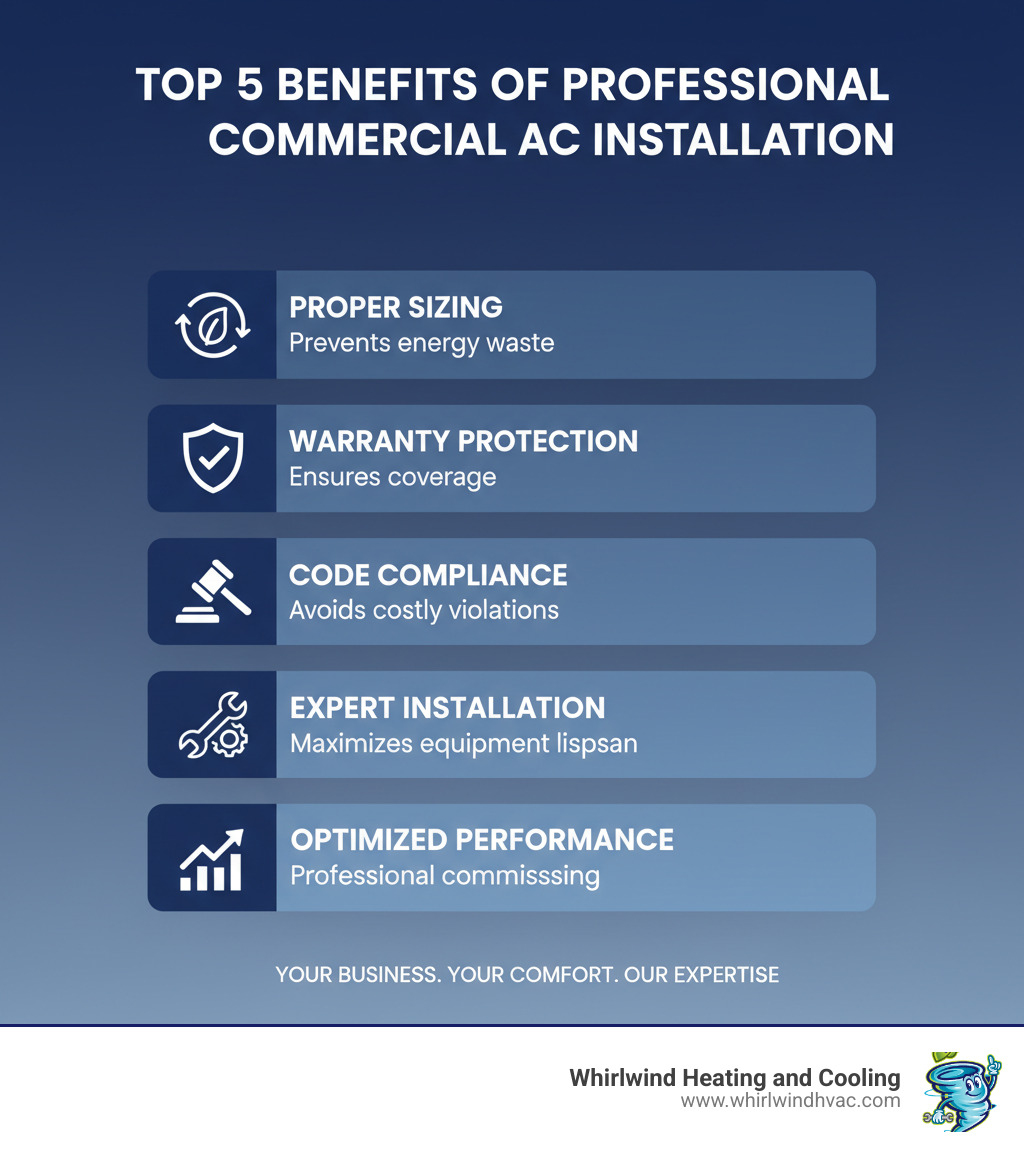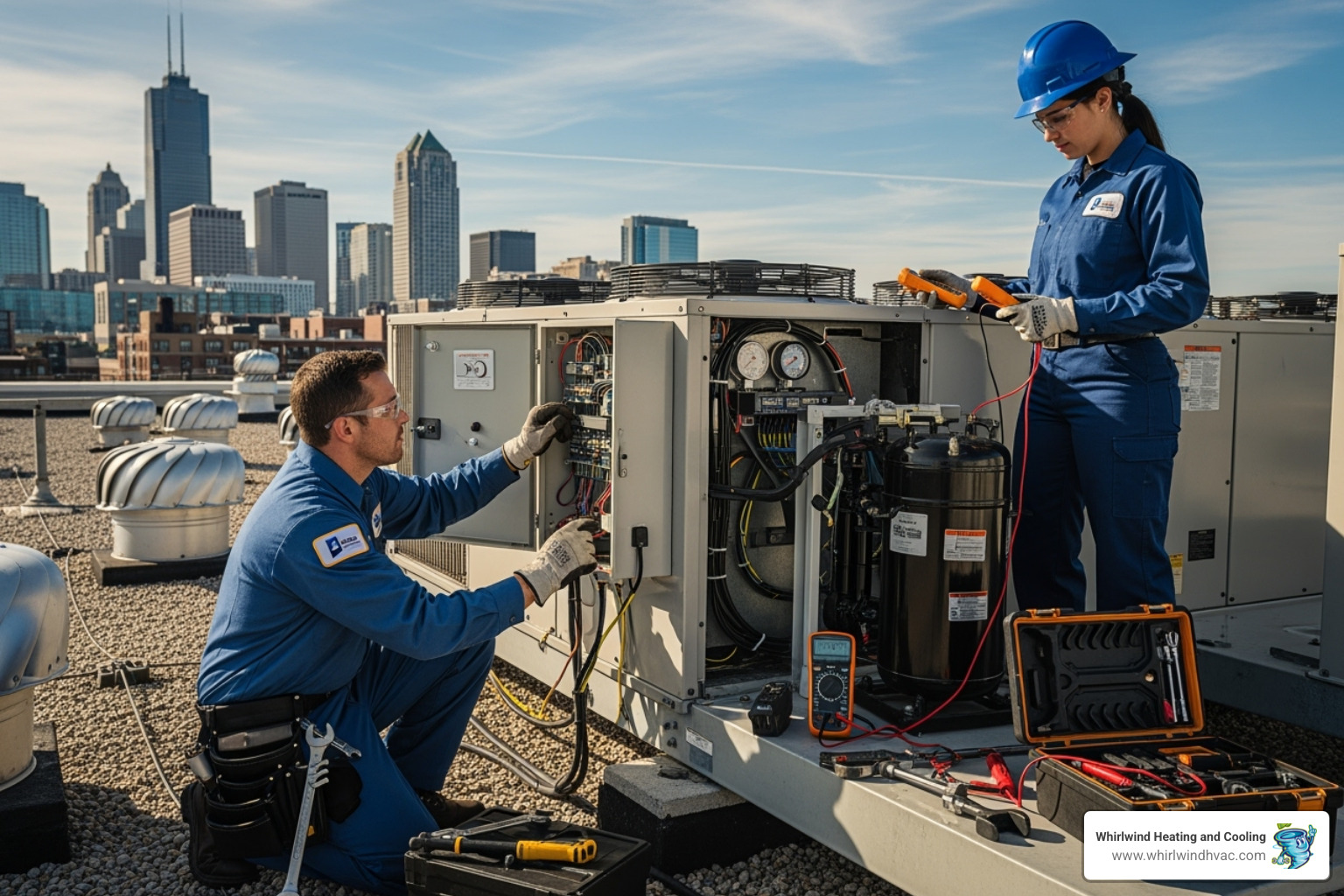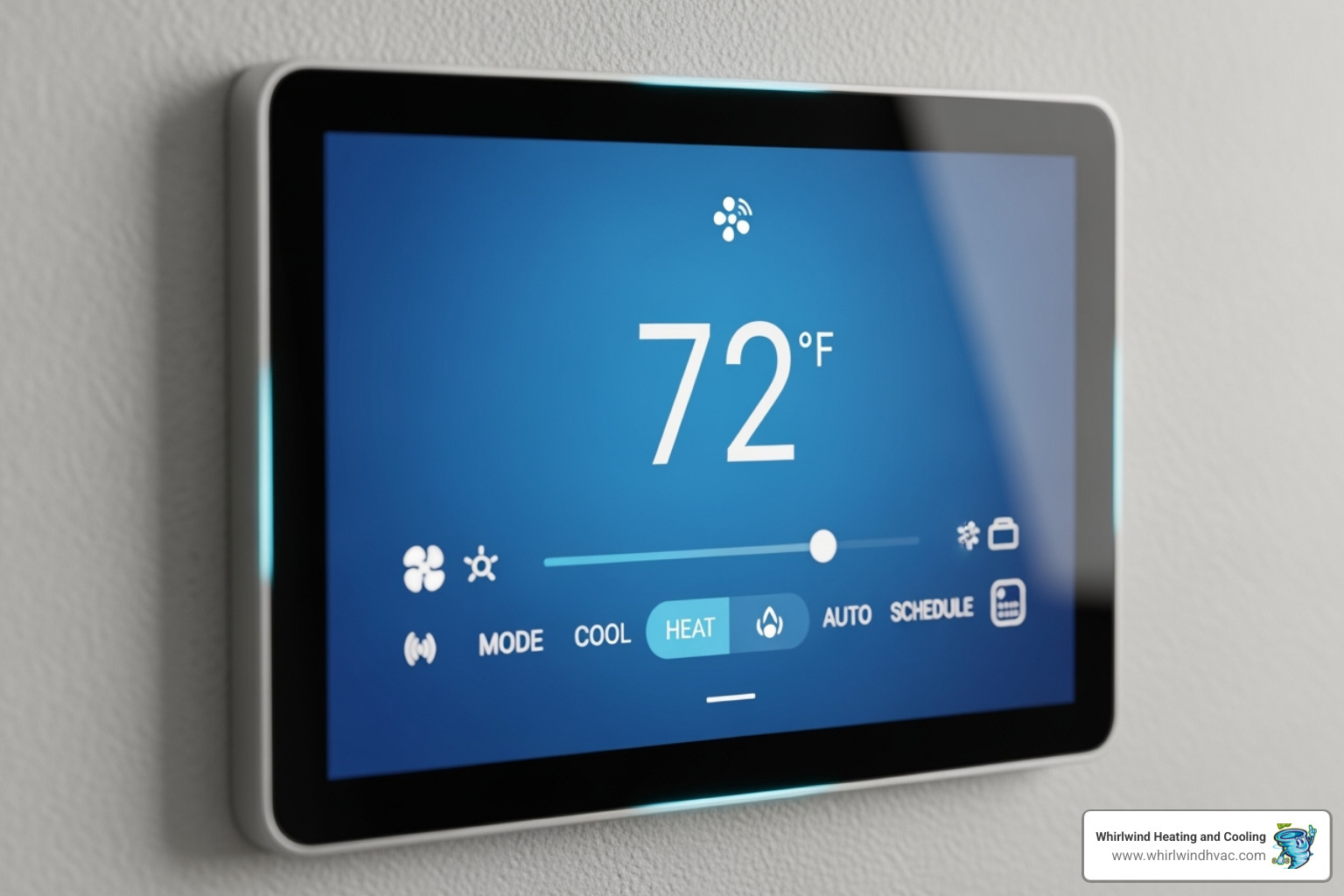Why Your Business Needs Professional Commercial AC Installation
Commercial ac installation demands specialized expertise that goes far beyond residential HVAC work. When your business relies on comfortable temperatures for employees and customers, proper installation is critical to your bottom line.
Key Commercial AC Installation Services:
- System Assessment & Sizing – Manual J load calculations ensure proper capacity
- Professional Installation – NATE-certified technicians handle complex commercial systems
- Permit Management – Licensed contractors steer local building codes
- Ductwork Design – Proper airflow balance and sealing prevent energy loss
- System Commissioning – Complete testing ensures optimal performance from day one
Commercial air conditioning systems are large and complex, often involving rooftop units, extensive ductwork, and three-phase power connections that require trained, certified technicians.
The stakes are high when installation goes wrong. Improper installation can lead to premature equipment failure, higher energy bills, and uncomfortable working conditions that reduce productivity and drive away customers.
Properly installed commercial AC units have a life expectancy of 10-15 years. Incorrect installation can significantly shorten this lifespan while increasing operating costs from day one. A complete installation project typically takes two to four weeks, though the physical installation may only require a few days.
Why Professional Installation is a Critical Business Investment
An uncomfortably warm business on a hot day loses customers fast. This shows why professional commercial ac installation is about protecting your reputation and bottom line, not just installing equipment. A professionally installed system boosts employee productivity, encourages customers to stay longer, and keeps energy bills reasonable.
Conversely, improper installation is costly. A poorly installed system works harder for less cooling, wasting energy and money. Professional installation is a critical investment for several key reasons:
- System Efficiency: Professional installation ensures your unit operates exactly as the manufacturer designed it, with every component working in harmony for optimal performance and lower operational costs.
- Warranty Validation: Most manufacturers require professional installation to validate their warranties. Skipping this step could void thousands of dollars in coverage, leaving you to pay for future repairs out of pocket.
- Safety Standards: Commercial HVAC systems involve high-voltage electricity and pressurized refrigerants. Our certified technicians follow strict safety protocols to protect your building, people, and investment.
- Long-Term Savings: A properly installed system can last 15 years with regular maintenance, while a botched job might fail in just 5-7 years. The energy savings and extended lifespan mean professional installation pays for itself many times over.
Smart business owners know that doing it right the first time costs less than fixing it later. For more insights, see the Importance of Proper AC Installation.
The Dangers of an Improperly Sized System
Sizing a commercial AC system is crucial—too small and it won’t cool properly; too big and it wastes money. The key is a Manual J load calculation, a detailed analysis of your building’s unique characteristics, including square footage, insulation, window types, occupancy, and heat-generating equipment.
- Undersized Units: An undersized unit runs constantly, struggling to cool the space. This leads to high energy bills, uncomfortable conditions, and premature equipment failure.
- Oversized Units: An oversized unit cools too quickly, shutting off before it can properly dehumidify the air. This creates a clammy, uncomfortable feeling. This rapid on-and-off process, known as short-cycling, wastes energy and causes increased wear and tear on components, leading to frequent breakdowns.
Improper sizing also leads to humidity issues, harming indoor air quality and comfort. As this resource on why an oversized HVAC unit is a problem explains, getting the size wrong creates expensive, long-term issues.
Commercial vs. Residential Installation: Key Differences
Commercial AC installation is far more complex than residential work, like comparing a skyscraper to a house. The expertise and equipment required are in completely different leagues.
- System Size and Complexity: A home may need a 5-ton unit, but a commercial building could require 50 tons or more. These systems are engineered differently to handle massive, zoned cooling loads for areas like server rooms, kitchens, and conference rooms.
- Location and Type: Commercial installations often use packaged rooftop units to save valuable interior space, whereas most homes use split systems.
- Drainage and Ductwork: Commercial units produce gallons of condensate, requiring sophisticated drainage systems. The ductwork scale is also massive, demanding specialized engineering to balance airflow and minimize energy loss.
- Power Requirements: Commercial units typically need complex three-phase power systems, which are far more robust than standard residential electrical connections.
These differences highlight why commercial ac installation requires specialized training, licensing, and experience. For more on this, explore Modern AC Solutions for New Construction.
Choosing the Right Commercial AC System for Your Needs
Selecting the right commercial ac installation is vital for your comfort, energy bills, and peace of mind. Every business has unique cooling needs, and our goal is to find the perfect match for you.
During a consultation, we assess several key factors to determine the best system for your business:
- Building Size and Layout: A sprawling warehouse requires a different approach than a multi-story office building or a small boutique.
- Occupancy Load: A busy restaurant with a high customer turnover generates more heat than a quiet accounting office.
- Business Type: A server room needing 24/7 cooling has different requirements than a retail store that only operates during business hours.
- Budget Considerations: We help you find the right balance between upfront investment and long-term savings from a high-efficiency system.
Our goal is to match you with a system that keeps your business comfortable while staying within your budget. For more guidance, see our guide on Choosing the Perfect AC Installation.
Common Types of Commercial Air Conditioners
Commercial air conditioning offers several options, each suited for specific applications.
| System Type | Best For | Cost (General) | Efficiency (General) |
|---|---|---|---|
| Packaged Rooftop Units | Large, open commercial spaces (retail, warehouses, offices) | Medium to High | Good |
| Split-Systems | Smaller commercial buildings, zoned cooling needs, spaces with limited roof access | Medium | Very Good |
| VRF/VRV Systems | Multi-zone buildings, hotels, large offices, demanding precise temperature control | High | Excellent |
| Ductless Mini-Splits | Small offices, server rooms, spaces without existing ductwork, supplemental cooling | Low to Medium | Excellent |
- Packaged Rooftop Units: These reliable, self-contained systems are the workhorses of commercial cooling, ideal for large, open spaces.
- Split-Systems: Working like larger-scale residential units, these are great for businesses needing zoned cooling or those with limited roof space.
- VRF/VRV Systems: These high-tech systems can heat and cool different zones simultaneously, offering precise temperature control for large offices or hotels.
- Ductless Mini-Splits: These are perfect problem-solvers for cooling single areas like server rooms or spaces without existing ductwork.
Essential Components of a Commercial AC System
Every commercial AC system relies on key components working in unison:
- Compressor: The heart of the system, it pumps refrigerant to begin the cooling cycle.
- Condenser Coil: Located in the outdoor unit, this coil releases heat from the refrigerant.
- Evaporator Coil: Found in the indoor unit, this coil absorbs heat from your indoor air, creating the cooling effect.
- Air Handler: This unit contains the evaporator coil and a powerful fan to circulate conditioned air.
- Thermostat: The brain of the operation, modern thermostats allow for smart programming and remote control.
- Ductwork: This network of channels delivers cool air throughout your building.
- Vents and Grilles: These are the outlets that distribute conditioned air into your space.
Our team specializes in all aspects of Commercial HVAC Services, ensuring every part of your system works perfectly together.
The Commercial AC Installation Process from Start to Finish
Investing in a new commercial ac installation can seem complex, but with the right partner, it’s a smooth process that improves your business’s comfort and efficiency.
A complete commercial ac installation project typically takes two to four weeks from consultation to completion. The physical installation itself usually only takes a few days, depending on system complexity. The overall timeline accounts for potential delays from equipment delivery or the permit approval process, and we keep you informed every step of the way.
Our process includes:
- Initial Consultation and Assessment: We evaluate your space, current system, comfort goals, and budget.
- System Design and Engineering: We perform Manual J load calculations to size the system perfectly and design efficient ductwork.
- Permitting and Approvals: We handle all the paperwork, navigating local building codes to secure necessary permits.
- Equipment Ordering and Delivery: We coordinate with suppliers and provide you with delivery schedule updates.
- Decommissioning Your Old Unit: If replacing a system, we safely remove and responsibly dispose of the old equipment.
What to Expect During Your Commercial AC Installation
On installation day, our certified technicians work efficiently to minimize disruption to your business operations.
- Site Preparation: We begin by protecting your property and implementing safety measures.
- Unit Placement: Using cranes and specialized equipment, we safely and accurately position the new unit, especially on rooftops.
- Electrical Work: Our licensed electricians handle all wiring, ensuring your system has the proper three-phase power supply and meets all electrical codes.
- Ductwork Connection: We connect the new unit to your duct system, modifying it as needed for optimal airflow.
- System Testing and Commissioning: We bring the system to life, testing every component and calibrating controls to ensure flawless performance from day one.
This meticulous approach ensures your installation is done right the first time. We bring this same dedication to every project, including Seamless Heater Installation.
Ductwork Design and Sealing Implications
Ductwork is your building’s circulatory system; its design and integrity are critical for comfort, efficiency, and air quality. Proper airflow balance prevents frustrating hot and cold spots. More importantly, preventing air leaks is essential.
Leaky ductwork can waste 20-30% of your cooling energy and lead to other problems:
- Pest Infestations: Gaps can become entry points for rodents and insects.
- Water Damage: Improperly sealed connections can allow moisture to damage walls and ceilings.
- Poor Indoor Air Quality: Leaks can pull dust, allergens, and pollutants from unconditioned spaces into the air you breathe.
Properly sealed ductwork protects your bottom line and ensures a healthier indoor environment. In some cases, ductless systems can bypass these issues entirely, as discussed in our guide to a Ductless Heater for New Homes.
Permit Requirements and Choosing a Qualified Contractor
Choosing a qualified contractor and handling permits correctly from the start saves time, money, and future headaches. Local building codes in cities like Woodburn and Salem exist to ensure safety and proper operation. We handle the entire permitting process, so you can be confident your system meets all legal standards.
When choosing a contractor, look for these qualifications:
- Licensed and Insured: This protects you from liability and proves they meet industry standards.
- NATE and EPA Certification: These certifications show technicians have up-to-date expertise and follow environmental best practices.
- Written Estimates: A detailed, written estimate provides transparency on all costs, labor, and timelines.
As a Trade Ally with Energy Trust of Oregon incentives, we are committed to providing energy-efficient solutions. When you’re ready for expert commercial ac installation, check out our AC Installation in Salem, OR services.
Maximizing Efficiency and Long-Term Value
Your new commercial ac installation is just the beginning. To get the most from your investment, it’s important to focus on maximizing its long-term value and efficiency.
To maximize efficiency, look for high SEER ratings and Energy Star certification. Higher ratings mean lower monthly utility bills. Smart features like programmable controls and zoned cooling further reduce costs by cooling only when and where it’s needed. You can schedule cooling around business hours or maintain different temperatures in a server room versus a storage area. These features are powerful money-savers. For more tips, see What to Consider Before AC Installation.
Signs You Need a Replacement Instead of a Repair
Even the best commercial AC units have a limited lifespan. Knowing when to replace your system can save you from wasting money on constant repairs. Watch for these signs:
- System Age: If your unit is over 10-15 years old, replacement is often more cost-effective than continued repairs.
- Frequent Breakdowns: Calling for service more than twice a year is a red flag that a new system is a better investment.
- Rising Energy Bills: A steady, unexplained increase in your utility bills often points to declining system efficiency.
- Uneven Cooling: Hot and cold spots throughout your building mean the system can no longer distribute air effectively.
- Strange Noises or Odors: Grinding, banging, or musty smells usually indicate serious internal problems that are expensive to fix.
Post-Installation Maintenance for System Longevity
How you care for your system after installation is just as important as the installation itself. Commercial systems run constantly, making our preventative maintenance plans essential for protecting your investment and catching small problems before they become expensive ones.
Key maintenance tasks include:
- Regular Filter Changes: To ensure proper airflow and maintain good indoor air quality.
- Coil Cleaning: To keep the system transferring heat efficiently and reduce energy consumption.
- Refrigerant Level Checks: To guarantee optimal cooling performance.
- Electrical Connection Inspections: To prevent unexpected shutdowns and safety hazards.
- Drainage System Cleaning: To avoid water damage and humidity problems.
A good maintenance plan extends your system’s life, keeps energy bills low, and prevents costly emergency repairs, a principle that also applies to heating, as detailed in the Benefits of Heater Installation.
Latest Technologies in Commercial AC
Today’s commercial ac installation offers advanced technologies for greater efficiency and control:
- Variable-Speed Compressors: These systems adjust their output to precisely match cooling demand, saving energy, reducing noise, and improving comfort.
- Smart Thermostats: Modern controls learn your usage patterns, provide energy reports, and allow for remote control via your phone.
- Off-Site Energy Monitoring: This technology allows technicians to monitor your system’s performance remotely and identify potential issues early.
- Advanced Air Purifiers: Systems like the REME Halo can be integrated into your ductwork to neutralize pollutants, allergens, and viruses.
- Geothermal Systems: These systems use the earth’s stable temperature for incredibly efficient heating and cooling, offering substantial long-term energy savings.
We help clients explore these exciting possibilities. Learn more about our local expertise with AC Installation in Keizer, OR.
Frequently Asked Questions about Commercial AC Installation
Business owners considering a new commercial ac installation often have similar questions. Here are answers to the most common ones we hear.
How long does a typical commercial AC installation take?
The entire project, from consultation to commissioning, typically takes two to four weeks. This timeline accounts for system design, permitting, and equipment delivery. The physical installation itself is much faster, usually completed in a few days to a week, depending on complexity. Delays can occur due to permit approvals or equipment availability, but we keep you informed throughout the process.
What factors have the biggest impact on installation cost?
Several factors influence the cost of a commercial ac installation. We provide transparent, detailed estimates so you know exactly what to expect. Key factors include:
- System Size (Tonnage): Larger capacity units for bigger spaces cost more.
- System Type: A complex VRF system with multiple zones is more expensive than a standard rooftop unit.
- Efficiency (SEER Rating): Higher-efficiency units have a larger upfront cost but provide long-term energy savings.
- Installation Complexity: Factors like needing a crane for rooftop placement, electrical system upgrades, or significant ductwork modifications add to the cost.
Can I finance a new commercial AC system?
Yes. We understand a new commercial ac installation is a major investment, and financing is a smart way for businesses to manage the cost. It allows you to get the right high-efficiency system without a large upfront capital expense. Often, the monthly energy savings help offset the financing payments.
We partner with several lenders to offer flexible options, including low-interest rates and promotional periods for qualified businesses. This helps you manage cash flow while upgrading your building’s comfort and efficiency. Ready to explore your options? Check out our HVAC Financing in Woodburn, OR page to learn more.
Your Partner for Reliable Commercial Cooling
A commercial ac installation is a strategic investment in your business’s future, impacting everything from operating costs to employee productivity and customer satisfaction. A properly installed system works efficiently in the background, providing reliable comfort year after year. This is the standard we deliver for businesses throughout the Willamette Valley.
At Whirlwind Heating and Cooling, our mission is simple: “Do it right, at a fair price.” We deliver quality service, fair pricing, and responsive communication on every project, from Woodburn to Salem, Portland, and across our service area.
Professional installation ensures longevity, optimal performance, and peace of mind. By working with our certified technicians, you protect your investment for the long haul. A professionally installed system isn’t just about immediate comfort—it’s about creating the perfect environment for your business to thrive.
Ready to experience the difference that expert installation can make? Request an estimate for your AC installation in Woodburn, OR today! Let’s work together to keep your business cool, comfortable, and running efficiently.





